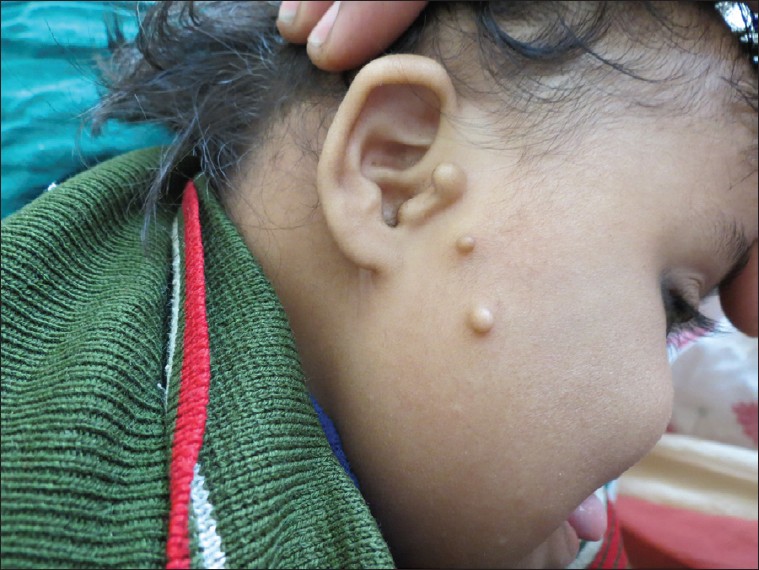Translate this page into:
Multiple accessory tragi in a case of Down's syndrome
Correspondence Address:
Prashant Verma
Skin, Hair & Laser Clinic, K-1/13, Model Town-3, Delhi-9
India
| How to cite this article: Verma P. Multiple accessory tragi in a case of Down's syndrome. Indian J Dermatol Venereol Leprol 2012;78:776 |
Sir,
A 3-year-old girl, known case of Down′s syndrome, presented to our department with asymptomatic skin-colored raised lesions over the right cheek. According to the mother, the lesions had been present since birth and she was her only child. History of pregnancy was unremarkable with no history of alcohol, tobacco, or drug abuse. The child was born of an uneventful normal vaginal delivery. There was no significant family history. Examination revealed small, soft to firm, skin-colored papules present in a linear distribution from the right preauricular region, along the line of the mandible [Figure - 1]. Excess neck skin, turned down mouth corners, hypotonia, flat face, dysplastic ears, epicanthic folds, webbed toes, and protruding tongue were the additional features on examination. In addition, there was a bilateral conductive hearing loss more so on the right side. She could only sit without support and utter only monosyllabic sounds, which implied delayed milestones. Systemic examination was normal. The parents refused for a biopsy of the tragi. Echocardiogram, ultrasound of the abdomen, kidney, ureter, and bladder, was unremarkable as were spinal radiographs. No abnormality was evident on computed tomographic and magnetic resonance imaging of the head and neck. Thyroid, renal, and liver functions were normal too. Complete blood counts did not reveal any abnormality.
 |
| Figure 1: Multiple skin-colored nodules, the accessory tragi, distributed linearly along the jaw line, and protruding tongue |
Down syndrome, a well-known chromosomal anomaly, is characterized by mental retardation, dysmorphic facial features, and other distinctive phenotypic traits. Down syndrome is primarily caused by trisomy of chromosome 21; this is the most common trisomy among live births. [1] Accessory tragus represents a minor abnormality of the first branchial arch and its incidence has been estimated at 1.7:1,000. [2] Congenital nodules, single or multiple, soft or firm, and skin-colored, located in the preauricular region, anterior to the tragus are the clinical features. Differential diagnosis of multiple accessory tragi, a rare entity, comprises the syndromes, namely Goldenhar (oculo-auriculo-vertebral spectrum), Treacher-Collins, Townes-Brocks, Vacterl, Wolf-Hirschhorn, Delleman, and Haberland (encephalocraniocutaneous lipomatosis). [3],[4],[5] Nonetheless, multiple accessory tragi have not been described in association with Down′s syndrome so far. First and second branchial arch defects, known in Down′s syndrome [6] could have been responsible for the multiple accessory tragi in the present case. Interestingly, in a recent report of multiple accessory tragi associated with Delleman′s syndrome, two paternal cousins of the child had Down′s syndrome. [4] A genetic analysis could have been complementary to contemplate the association between Down′s syndrome and accessory tragi; however, unfortunately, the facility was not available at our center. To conclude, it is imperative to take cognizance of congenital anomalies including Down′s syndrome when dealing with multiple accessory tragi.
| 1. |
Levenson D. Talking about Down syndrome. Am J Med Genet A 2009;149A:7-8.
[Google Scholar]
|
| 2. |
Jansen T, Romiti R, Altmeyer P. Accessory tragus: Report of two cases and review of the literature. Pediatr Dermatol 2000;17:391-4.
[Google Scholar]
|
| 3. |
Agim NG, Hunt CM, Williams VL, Metry DW. Multiple congenital facial papules-quiz case. Multiple accessory tragi and aplasia cutis congenita in association with Delleman (oculocerebrocutaneous) syndrome. Arch Dermatol 2011;147:345-50.
[Google Scholar]
|
| 4. |
Lam J, Dohil M. Multiple accessory tragi and hemifacial microsomia. Pediatr Dermatol 2007;24:657-8.
[Google Scholar]
|
| 5. |
Miller TD, Metry D. Multiple accessory tragi as a clue to the diagnosis of the oculo-auriculo-vertebral (Goldenhar) syndrome. J Am Acad Dermatol 2004;50:S11-3.
[Google Scholar]
|
| 6. |
Mazzoni DS, Ackley RS, Nash DJ. Abnormal pinna type and hearing loss correlations in Down's syndrome. J Intellect Disabil Res 1994;38:549-60.
[Google Scholar]
|
Fulltext Views
3,099
PDF downloads
3,015





